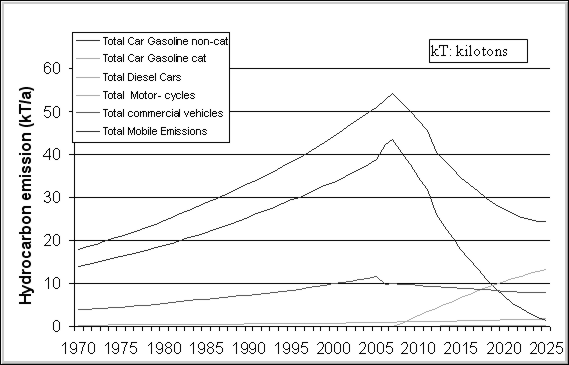
 |
| Block 8: Environmental Issues and Public Health - Air Pollution Chapter 4: The Principal Sources Of The Common Air Pollutants; Methods Of Estimating Emission Rates (Continued) |
Mobile sources refer mainly to emissions from cars, trucks, minibuses and buses. The fuel source may be petrol or diesel, and emissions include exhaust emissions and fugitive emissions. The procedure is complex, as is illustrated in the diagram (Figure 4-4) below.
The vehicle population is characterised by size and type. The car population is divided into three size classes:
Diesel fueled vehicles are similarly divided into size and type classes.
(For details of the methodology, see the paper by Mert and Cairncross.)
Table 4.5 lists typical mobile source emissions in the United States.
| US EPA List of Mobile Source Air Toxics | ||
|---|---|---|
| Acetaldehyde Acrolein Arsenic Compounds Benzene 1,3-Butadiene Chromium Compounds Dioxin/Furans |
Diesel Exhaust Ethylbenzene Formaldehyde n-Hexane Lead Compounds Manganese Compounds Mercury Compounds |
MTBE Naphthalene Nickel Compounds Polycyclic Aromatic Hydrocarbons (PAH) Styrene Toluene Xylene |
A number of these compounds (benzene, butadiene, lead compounds, .. ) are known or suspected carcinogens. Vehicle emissions include SO2, PM, NOx, VOCs and Pb.
Emissions per km travelled depend on vehicle type (petrol or diesel), size, speed, engine design and emission control technology. Tables 4.5 to 4.9 illustrate the differences in emissions per km with and without emission control devices.
Note the progressive reduction in emissions (for example, NOx emissions decrease from 2.24 g/km in Table 4.5 to 0.52 g/km in Table 4.9) due to the improvement in emission control technology.
Total emissions in a given area may be estimated using the following general relationship:
Emission Rate = Emission Factor x Activity Rate
A complex example of the application of emission factors and other input data is the emission inventory that is currently being developed for the Cape Metropolitan Area (CMA), under the DAPPS (Dynamic Air Pollution Prediction System) project:

|
| Figure 4.5: Mobile Emissions for the CMA: Hydrocarbons (kT/a) |